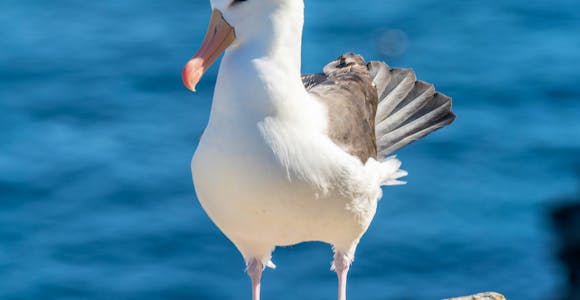
West Point Island
West Point Island is home to a large cliffside colony of black-browed albatross at the end of a hillside hike, which makes it a popular call for expedition cruise ships.
Discover More
The cliffs on the western side of New Island – a seabird haven
The human history of New Island reaches back to the earliest visitors to the Falkland Islands. Just as today, people were drawn here by its rich wildlife, though the attraction in the late 18th and early 19th centuries was a rather bloodier one.
American sealers were among the first to regularly call here to cull its wildlife for the booming fur trade. Captain Barnard of the ship Narnia and his crew spent 18 months here in 1814–14 after their vessel was commandeered by the shipwrecked crew they attempted to aid, only to find themselves in need of rescue themselves.
Throughout the 19th century there were several attempts to create a guano extraction industry from the deposits left by the resident seabirds, as well as the culling of penguins for their oil. In the early 20th century, New Island was home to a major whaling station until the operation was shifted to the more profitable waters of South Georgia. The island was then given over to sheep farming.
Since the 1970s the island has been a nature reserve and is now owned by the New Island South Conservation Trust. The small Barnard Museum at the settlement tells the maritime history of the islands and is named for the unfortunate stranded captain of two centuries ago. It overlooks the wreck of Protector III, a 1940s minesweeper-turned-sealer, that was abandoned here in 1969.

A black-browed albatross chick on New Island demands a meal from its parent
The western cliffs of New Island are home to one of the most thrilling seabird colonies it's possible to visit in the Falkland Islands. Black-browed albatrosses dominate here, but their tall mud pot nests are intermingled with those of both imperial shags and rockhopper penguins. Wherever you look there is constant bustle and noise. Some rockhoppers evidently find it a bit too much and have taken themselves off into the nearby tussac grass to nest.
This mass of life attracts plenty of aerial predators. Above the colony, look out for Falklands skuas (another species that nests in the tussac), turkey vultures, striated caracaras and dolphin gulls, all on the lookout for a meal of eggs, chicks or carrion.
The beaches of the eastern side of the island are home to Gentoo penguins and Magellanic penguins. The main rookeries are generally some distance from where expedition cruise ship passengers disembark, but it's common to see them in the water.
North of the settlement, at Landsend Bluff, there is a large South American fur seal colony. The waters around the island are good for spotting Commerson's dolphins and Peale's dolphins. While not common Southern right whale sightings are not unknown here.
Price Match Promise - We’ll match any price you find elsewhere for the same trip
Landings at New Island are made on the sheltered eastern side of the island at Coffins Harbour, near the wreck of Protector III. From here it is a walk of around half a mile slightly uphill to the opposite side of the island to the large seabird colony. The gorse bushes that line the walk are good for spotting local songbird species.
While is important to always observe the Falkland Islands Countryside Code and keep at least 6m away from wildlife, it is particularly important not to disturb any part of the colony especially any areas marked with colour pegs, as these indicate areas that form part of the long-term study of the birds in the colony.
Landsend Bluff, home to the island's fur seals is about an hour's walk north of the settlement – a visit here is dependent on how long you will have for your landing here.
NOTE: Ship itineraries and visits to specific landing sites in the Falkland Islands can never be guaranteed. Plans can change as fast as the weather in the South Atlantic: decisions on which locations to visit are always made on the day by the ship's captain and expedition leader.

West Point Island is home to a large cliffside colony of black-browed albatross at the end of a hillside hike, which makes it a popular call for expedition cruise ships.
Discover More
Saunders Island offers the chance to see four penguin species in one Falklands location, as well as a black-browed albatross colony
Discover More
The white sandy beaches of Carcass Island are a popular draw for expedition cruise ships, with visitors coming here for the colonies of magellanic and gentoo penguins.
Discover More
The narrow curved line of Bleaker Island is a great place for birdwatching, with three species of penguin, an enormous imperial shag colony and plenty of waterfowl.
Discover MoreWe'll spend some time listening to your aspirations, then discuss the kind of experience that might suit you.
Next we'll discuss the options, shortlist the best trips for you and present you our impartial recommendations.
We'll place a 24 hour hold on your preferred option - without obligation - whilst we talk through the details.